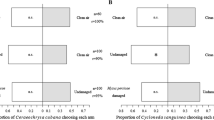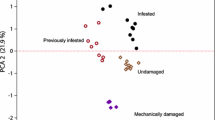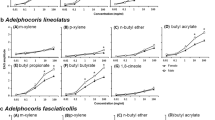Abstract
Behavioral and electrophysiological studies on aphid responses to host plant odors, although important, are still not exhaustive for some species. Moreover, most studies have not focused on whether these responses are mediated by odors from plants infested by conspecific and heterospecific individuals. Here, our goal was to identify the chemical cues involved in the attraction of the cabbage aphid (Brevicoryne brassicae L.) to cabbage plants. To achieve this, we collected volatiles emitted from uninfested cabbage plants, cabbage plants infested by either B. brassicae (conspecifics) or by diamondback moth (Plutella xylostella) larvae (heterospecifics), and from aphids alone. Choice tests revealed that B. brassicae were mostly attracted to odors from conspecific-infested cabbage plants; however, they also showed attraction to odors from uninfested plants and plants infested by P. xylostella larvae and were least attracted to odors from aphids alone. Using coupled Gas chromatography-Electroantennographic detection studies (GC-EAD) and Gas chromatography–Mass spectrometry (GC–MS), we revealed some chemically active compounds that elicited B. brassicae olfactory response, with more of these compounds in the cabbage plant infested by conspecific than in the rest of the treatments. It is possible that the knowledge gained from this work could pave the way for synthetic lures as an integrated pest management approach for B. brassicae. Therefore, more studies would need to be conducted to validate and isolate those exact compounds that positively excited the cabbage aphids’ olfactory response.








Similar content being viewed by others
Data Availability
The authors confirm that the data that support the findings of this study are available within the article.
References
Ahmed Q, Agarwal M, Alobaidi R et al (2022) Response of aphid parasitoids to volatile organic compounds from undamaged and infested Brassica oleracea with Myzus persicae. Molecules 27:1522. https://doi.org/10.3390/molecules27051522
Badra Z, Larsson Herrera S, Cappellin L et al (2021) Species-specific induction of plant volatiles by two aphid species in apple: real time measurement of plant emission and attraction of lacewings in the wind tunnel. J Chem Ecol 47:653–663. https://doi.org/10.1007/s10886-021-01288-5
Bhatia V, Uniyal PL, Bhattacharya R (2011) Aphid resistance in Brassica crops: challenges, biotechnological progress and emerging possibilities. Biotechnol Adv 29(6):879–888. https://doi.org/10.1016/j.biotechadv.2011.07.005
Bruce TJA (2014) Glucosinolates in oilseed rape: secondary metabolites that influence interactions with herbivores and their natural enemies. Ann Appl Biol 164(3):348–353. https://doi.org/10.1111/aab.12128
Cao HH, Liu HR, Zhang ZF, Liu TX (2016) The green peach aphid Myzus persicae perform better on pre-infested Chinese cabbage Brassica pekinensis by enhancing host plant nutritional quality. Sci Rep 6(1):21954. https://doi.org/10.1038/srep21954
Du Y-W, Shi X-B, Zhao L-C et al (2022) Chinese cabbage changes its release of volatiles to defend against Spodoptera litura. InSects 13:73. https://doi.org/10.3390/insects13010073
El-Sayed AM, Knight AL, Byers JA et al (2016) Caterpillar-induced plant volatiles attract conspecific adults in nature. Sci Rep 6:37555. https://doi.org/10.1038/srep37555
Faiola C, Taipale D (2020) Impact of insect herbivory on plant stress volatile emissions from trees: a synthesis of quantitative measurements and recommendations for future research. Atmospheric Environ X 5:100060. https://doi.org/10.1016/j.aeaoa.2019.100060
Fereres A, Kampmeier GE, Irwin ME (1999) Aphid attraction and preference for soybean and pepper plants infected with potyviridae. Ann Entomol Soc Am 92:542–548. https://doi.org/10.1093/aesa/92.4.542
Guerrieri E, Digilio MC (2008) Aphid-plant interactions: a review. J Plant Interact 3:223–232. https://doi.org/10.1080/17429140802567173
Holopainen J, Blande J (2013) Where do herbivore-induced plant volatiles go? Front Plant Sci 4:185
Humphreys RK, Ruxton GD, Karley AJ (2021) Post-dropping behavior of potato aphids (Macrosiphum euphorbiae). J Insect Behav 34:223–239. https://doi.org/10.1007/s10905-021-09784-y
Hussain M, Gao J, Bano S et al (2020) Diamondback moth larvae trigger host plant volatiles that lure its adult females for oviposition. InSects 11:725. https://doi.org/10.3390/insects11110725
Joshi S, Rabindra RJ, Rajendran TP (2010) Biological control of aphids. J Biol Control 24:185–202
Kiptoo J, Kasina M, Wanjala F et al (2015) Use of low cost pest exclusion nets can boost cabbage yield. East Afr Agric for J 81:112–119. https://doi.org/10.1080/00128325.2015.1130460
Kiryu M, Hamanaka M, Yoshitomi K et al (2018) Rice terpene synthase 18 (OsTPS18) encodes a sesquiterpene synthase that produces an antibacterial (E)-nerolidol against a bacterial pathogen of rice. J Gen Plant Pathol 84:221–229. https://doi.org/10.1007/s10327-018-0774-7
Kuack D (2020) Diamondback moth: the bane of brassica crop growers—IR-4 project. https://www.ir4project.org/news/novaluron-brassica-2020/. Accessed 25 Oct 2022
Li Y, Dicke M, Kroes A et al (2016) Interactive effects of cabbage aphid and caterpillar herbivory on transcription of plant genes associated with phytohormonal signalling in wild cabbage. J Chem Ecol. https://doi.org/10.1007/s10886-016-0738-3
Liu Z, Wang H, Xie J, Lv J, Zhang G, Hu L et al (2021) The roles of cruciferae glucosinolates in disease and pest resistance. Plants (basel). https://doi.org/10.3390/plants10061097
McCormick AC, Reinecke A, Gershenzon J, Unsicker SB (2016) Feeding experience affects the behavioral response of polyphagous gypsy moth caterpillars to herbivore-induced poplar volatiles. J Chem Ecol 42:382–393. https://doi.org/10.1007/s10886-016-0698-7
Munthali DC, Tshegofatso AB (2014) Factors affecting abundance and damage caused by cabbage aphid, Brevicoryne brassicae on four Brassica leafy vegetables: Brassica oleracea var. Acephala, B. chinense, B. napus and B. carinata. Open Entomol J 8:1–9. https://doi.org/10.2174/1874407901408010001
Nicolopoulou-Stamati P, Maipas S, Kotampasi C et al (2016) Chemical pesticides and human health: the urgent need for a new concept in agriculture. Front Public Health 4:148
Pagadala Damodaram KJ, Gadad HS, Parepally SK et al (2021) Low moisture stress influences plant volatile emissions affecting herbivore interactions in tomato, Solanum lycopersicum. Ecol Entomol 46:637–650. https://doi.org/10.1111/een.13012
Pal M, Singh R (2013) Biology and ecology of the cabbage aphid, Brevicoryne brassicae (Linn.) (Homoptera: Aphididae): a review. J Aphidol Aphidol Soc India 27:59–78
Rodriguez-Saona CR, Stelinski LL (2009) Behavior-modifying strategies in IPM: theory and practice. In: Peshin R, Dhawan AK (eds) (pp 263–315). Springer, Netherlands. https://doi.org/10.1007/978-1-4020-8992-3_11
Rodriguez-Saona CR, Musser RO, Vogel H et al (2010) Molecular, biochemical, and organismal analyses of tomato plants simultaneously attacked by herbivores from two feeding guilds. J Chem Ecol 36:1043–1057. https://doi.org/10.1007/s10886-010-9854-7
Sobhy I, Bruce T (2021) Evolutionary ecology: plant volatile profile changes after escaping specialist insects. Curr Biol 31:R948–R971. https://doi.org/10.1016/j.cub.2021.06.043
Sobhy IS, Caulfield JC, Pickett JA, Birkett MA (2020) Sensing the danger signals: cis-Jasmone reduces aphid performance on potato and modulates the magnitude of released volatiles. Front Ecol Evol 7:499
Stotz HU, Pittendrigh BR, Kroymann J et al (2000) Induced plant defense responses against chewing insects. Ethylene signaling reduces resistance of arabidopsis against Egyptian cotton worm but not diamondback moth. Plant Physiol 124:1007–1018
Tan KH, Nishida R (2012) Methyl eugenol: its occurrence, distribution, and role in nature, especially in relation to insect behavior and pollination. J Insect Sci 12:56. https://doi.org/10.1673/031.012.5601
Turlings TCJ, Erb M (2018) Tritrophic interactions mediated by herbivore-induced plant volatiles: mechanisms, ecological relevance, and application potential. Annu Rev Entomol 63:433–452. https://doi.org/10.1146/annurev-ento-020117-043507
Turlings TCJ, Alborn HT, Loughrin JH, Tumlinson JH (2000) Volicitin, an elicitor of maize volatiles in oral secretion of spodoptera exigua: isolation and bioactivity. J Chem Ecol 26:189–202. https://doi.org/10.1023/A:1005449730052
Vanhaelewyn L, Van Der Straeten D, De Coninck B, Vandenbussche F (2020) Ultraviolet radiation from a plant perspective: the plant-microorganism context. Front Plant Sci 11:597642. https://doi.org/10.3389/fpls.2020.597642
Verheggen FJ, Haubruge E, Mescher MC (2010) Alarm pheromones—chemical signaling in response to danger. Vitamins & hormones. Elsevier, New York, pp 215–239
Walling LL (2000) The myriad plant responses to herbivores. J Plant Growth Regul 19:195–216. https://doi.org/10.1007/s003440000026
Webster B (2012) The role of olfaction in aphid host location. Physiol Entomol 37:10–18. https://doi.org/10.1111/j.1365-3032.2011.00791.x
Webster B, Bruce T, Dufour S et al (2008) Identification of volatile compounds used in host location by the black bean aphid, Aphis fabae. J Chem Ecol 34:1153–1161. https://doi.org/10.1007/s10886-008-9510-7
Wei J, van Loon JJA, Gols R et al (2014) Reciprocal crosstalk between jasmonate and salicylate defence-signalling pathways modulates plant volatile emission and herbivore host-selection behaviour. J Exp Bot 65:3289–3298. https://doi.org/10.1093/jxb/eru181
Winde I, Wittstock U (2011) Insect herbivore counteradaptations to the plant glucosinolate-myrosinase system. Phytochemistry 72(13):1566–1575. https://doi.org/10.1016/j.phytochem.2011.01.016
Xiao L, Carrillo J, Siemann E, Ding J (2019) Herbivore-specific induction of indirect and direct defensive responses in leaves and roots. AoB Plants 11:plz003. https://doi.org/10.1093/aobpla/plz003
Ye M, Veyrat N, Xu H et al (2018) An herbivore-induced plant volatile reduces parasitoid attraction by changing the smell of caterpillars. Sci Adv. https://doi.org/10.1126/sciadv.aar4767
Zimba KJ, Sohati PH, Munyinda K et al (2022) Induced mutagenesis: an underutilised component in the integrated management of aphid pests in sub-Saharan Africa. Crop Prot 159:106030. https://doi.org/10.1016/j.cropro.2022.106030
Acknowledgements
We would like to wholeheartedly thank Prof. Cesar Rodriguez-Saona for the arduous task of editing this manuscript, we really cherish and appreciate his efforts. We would also like to thank Dr Richa Varshney, Scientist, ICAR-National Bureau of Agricultural Insect Resources, Bengaluru, India for supplying us with the diamondback moth larvae culture for this experiment.
Funding
This research work was funded by the Department of Biotechnology, Govt. of India—The World Academy of Science, Italy (DBT-TWAS), FR Number: 3240313779.
Author information
Authors and Affiliations
Contributions
Material preparation, data collection, and analyses were performed by SM and SKP. The first draft of the manuscript was written by SM. KPDJ supervised the work and edited the manuscript. AKM co-supervised the work. YH and LV revised and edited the final version of the manuscript. All authors commented on previous versions of the manuscript and then read and approved the final manuscript.
Corresponding authors
Ethics declarations
Conflict of interest
The authors have no relevant financial or non-financial interests to disclose.
Additional information
Handling Editor: Ingeborg Menzler-Hokkanen.
Publisher's Note
Springer Nature remains neutral with regard to jurisdictional claims in published maps and institutional affiliations.
Rights and permissions
Springer Nature or its licensor (e.g. a society or other partner) holds exclusive rights to this article under a publishing agreement with the author(s) or other rightsholder(s); author self-archiving of the accepted manuscript version of this article is solely governed by the terms of such publishing agreement and applicable law.
About this article
Cite this article
Mustapha, S., Jayanthi, K.P.D., Parepely, S.K. et al. Behavioral and electrophysiological responses of cabbage aphids to odors from host plants infested by conspecific and heterospecific herbivores. Arthropod-Plant Interactions 18, 353–365 (2024). https://doi.org/10.1007/s11829-024-10038-9
Received:
Accepted:
Published:
Issue Date:
DOI: https://doi.org/10.1007/s11829-024-10038-9




